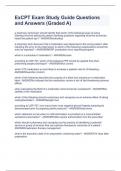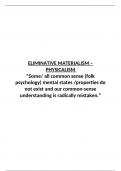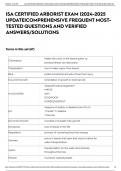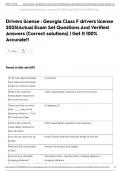LPC
PLP Consolidation Notes
SECTION 1: THE FREEHOLD SYSTEM
I. THE INITIAL STAGES IN A PROPERTY TRANSACTION
[1. Introduction]
Tabbing top purple
[What is the seller under a duty to disclose?]
Note principle of caveat emptor
BUT seller under a duty to disclose certain things to buyer in contract:
o Defect in title of which they have actual/constructive knowledge (except for anything buyer client is expected to discover
from inspection of property) e.g. the fact that an old conveyance is missing; break in chain of ownership
o Latent incumbrances (rights burdening land – cvts + easements) e.g. dispute with neighbour/cov saying that prop may not
be used for business purposes. Must burden the land or restrict use in a certain way. Includes:
Latent covenants
Latent easements
Thus, patent incumbrances do not have to be disclosed (bc they are rights discoverable on inspection)
o Patent = physical if seller is aware of damage, then should not state ‘not so far as seller is aware’
o Keep in mind P2 – integrity + O4.1 = confidentiality
And note that physical defects, even if not immediately obvious, are for the buyer to discover e.g. in its survey
Note also that seller’s duty to disclose under contract is contingent upon whether SCPC/SCS are incorporated (see below)
[What is buyer deemed to take property subject to?]
SCPC - commercial SCS - residential
Matter which the buyer is deemed to take the property subject to Cf. SCS:
are more extensive: SCS 3.1.2(d) + (e): buyer is only buyer subject to matter
SCPC 4.1.2(d): the buyer is deemed to buy the property within its actual knowledge and entries in any public
subject to such searches and enquiries which a prudent register pre-contract (and definition of ‘public register’
buyer would make (even if the actual buyer has not) doesn’t include the ones at Land Registry, the Land
Charges Dept and Companies House)
If seller fails to expressly disclose matters that the buyer is not deemed to have notice of under these provisions, then the buyer may still be
bound by those matters under land law but the seller may be liable for breach of contract
[2. Pre-contract searches + enquiries]
Can technically happen after investigation of title but wise to start with this bc they take a long time to come back and want to keep
updating report on title with results as they come in
By doing this, buyer’s solicitor can check for any unregistered third party interests and other matters affecting the property
[Searches + enquiries that are always carried out]
Search Why? How?
LLC1 + CON29 AKA the LOCAL search!
Local Land Reveals planning permissions, Conservation Area/Listed Use form LLC1 via NLIS (National
Charges Search Building status, enforcement notices, tree preservation Land Information Service); or
(LLC1) orders, smoke control orders etc. (NB. not the same as Send direct to Local Au (or Land
Central Land Charges Search carried out for unregistered land) Registry currently local
See granted PP + past breaches of planning laws authorities are migrating data to LR
[Additional info] as it becomes sole authority for
Register traditionally kept by London borough/rlvt local au LOCAL land charges search results)
BUT LR becoming sole registering authority
No priority period search is only meant to be accurate as at
the date upon which the official certificate was issued. In
practice, considered safe to rely on a search which is less than
3 months old at time of completion
Can also raise individual bespoke enquiries with LA not
covered by either CON29/CON29O again for additional fee
LA could be sued in neg for an erroneous reply to printed
enquiries (subject to validity of exclusion clause printed on
CON29 + CON29O forms)
Local Authority Reveals public roads, building regs, whether LA plans to Use form CON29 via NLIS; or
Enquiries adopt a road, contaminated land notice to check whether Send direct to LA
(standard property abuts highway! TO CONFIRM ROADWAY NOT
enquiries) Some overlap with LLC but building regs found here BEING ADOPTED!
(CON29) [Additional info] – reveals refused consent Ask about maintenance
Fee of about £150 If adjoining lanes (not private
If eg health and safety stuff reviewed state need to get info highways) are to be adopted =
1
, LPC
from local authority about action taken + ask seller if any RoW over roads as no easements
action taken [then get LA to remove] expressly granted
Commercial Reveals private/public services, if metered etc Via NLIS; or
Drainage + Liability of max £2m if erroneous replies Liaise direct with rlvt water
Water Search service co
Desktop Reveals contamination from former industrial use, if flooding Via NLIS; or
Environmental risk etc necessary bc owner may be liable EI not cause Other search provider e.g.
Search (Made in all transactions since Law Society’s Contaminated Sitecheck from Landmark
Land Warning Card); CON29 only gives LA notice of clean-up Information Group
o Make it conditional that seller cleans up site before
completion bc indemnity only as good as seller (may
go bankrupt in the future when trying to enforce)
Pre-Contract Reveals extra info known only to seller eg ORI, TP rights Using CPSEs available from
Enquiries of the CPSE – incorrect answers = potential liabilities Practical Law
Seller – CPSE1 EPC given here
Chancel Repair Reveals liability to contribute to maintenance of church Via search provider (e.g. Chancel
Search NB. Chancel repair liability = no longer an overriding interest Check); or
from 13 Oct 2013 pursuant to LRA 2002 but continues to Personal search of National
bind owner of land purchased before this until it is sold to TP (EI Archives
right not protected by notice at LR/OC) – post 2013 = should
appear in register = no liability if no notice in register Essentially they had until 2013 to register
Process of registering so charges register for a particular their right; if churches didn’t do this = still
property may not be conclusive – buyer should undertake a liable if it’s the same owner from before
traditional chancel repair search 2013. Right stops the moment it’s sold
(Usually made in all transactions but particularly in transactions
with CofE church nearby)
Structural To be carried out by buyer – BS to check if B has done this Physical attendance by client
Survey + because buyer instructs surveyor to inspect and/or surveyor hired by client
Physical Reveals physical defects, occupiers, boundary disputes etc
Inspection Valuation report (value), home buyer’s survey (residential –
indication of property condition), building survey (detailed
examination – essential for old buildings)
[Occupiers] – B to inspect for occupiers
o Buyer’s solicitor must ask seller to confirm whether
there are any occupiers apart from seller at property
o If yes, buyer will need to enquire into the possibility
that they may have a beneficial interest in the
property – obvious/known occupation = ORI LRA 2002
[Other searches + enquiries which may be relevant – depends on facts]
Don’t list out every search – wont get marks. Must be relevant!
Search Why? How?
Local Authority If need to raise rlvt optional enquiries particularly in respect of Use form CON29O via NLIS; or
Enquiries public footpaths and common land, town and village greens Send direct to LA
(CON29O) (Particularly relevant if concerns rural area and village green
(optional) nearby -- suspected public footpath crossing property; could
also be right of grazing)
Enquiry 22 – Commons Registration Act
[Additional info]
Additional fee required
Can also raise individual bespoke enquiries with LA not
covered by either CON29/CON29O again for additional fee
LA could be sued in neg for an erroneous reply to printed
enquiries (subject to validity of exclusion clause printed on
CON29 + CON29O forms)
Phase 1 Required if Desktop Search (above) reveals potential Via environmental search
Environmental environmental issues provider
Survey Followed by Phase 2 (but expensive
Company Search If seller is a company Via Companies House
Checks name and no, not insolvent, able to sell, reveals
fixed/floating charges etc
Index Map Search Normally only required if prop = unregistered, but Use Form SIM via NLIS; or
(SIM) recommended for commercial property and/or where Send direct Land Registry
needed to confirm owner of neighbouring land
Also reveals if any other TP title numbers are registered
against the prop e.g. lease
Confirms boundaries of title accord with plans
2
, LPC
Highways Requirement of CLLS Certificate of Title which will be sent to Specifically contact highways
Authority Search lender dept at LA
Required if commercial property If prop is close to a
Checks boundaries of highways abutting the property – motorway/trunk road will need
property must abut highway or property has RoW over road to contact the national Highways
abutting PH otherwise no legitimate access to proeprty Agency
also reveals ‘ransom strip’ (TP owner that can hinder proposed
use for developers)
Coal Mining If near local quarry/mining history Use Form CON29M Commercial
Search (CON29M) Reveals if coal mining has/is taking place, if subsidence risks via NLIS; or
present due to mining Send direct Coal Authority
Waterways If river passing through property Via NLIS; or
Search Reveals ownership of river banks and liability for Send letter rlvt body
maintenance of river banks
Basic Utilities For commercial property, dependent on instructions from Via NLIS; or
Searches e.g. gas, client/surveyor Write direct utility providers
electricity + Reveals if connected to services, identity of providers AWA
telecoms info for client about telecom masts inside the boundary of the
property
Flood Risk Must mention in all transactions the risk of flood to client Conduct searches, enquire from
seller, instruct surveyor to carry
out physical inspection
[Potential dangers in the seller refusing to reply to same/all of the pre-contract enquiries]
Buyer may become suspicious that there is a problem
If such matters relate to latent incumbrances/defects in title, could = breach of duty of disclosure
[Standard seller is held to: ‘not so far as the seller is aware’]
William Sindall v Cambridge County Council (1994): held that ‘not so far as the seller is aware’ will be interpreted by the courts as
representing that the seller has no actual knowledge of a matter AND has also made such investigations as could reasonably be
expected to be made
Gordon v Selico S cannot deliberately mislead B by concealing defects or answering dishonestly = BOC liabilities
[Potential liabilities for a seller re providing incorrect replies to enquiries]
[LLC1]
Person who enters into contract on basis of misleading/inaccurate reply is entitled to compensation: s 10 LLCA 1975 (NB doesn’t
have to be the person who instigated the search)
Remedy under SCPC or SCS is preferred unlike common law misrep = no requirement for B to prove they were induced to enter
into contract; B simply proves error or omission in their information!
[Generally]
Damages under SCS 7.1/SCPC 10.1
Misdescription
Misrepresentation
o Note that AAR possibility of claim for misrep, although seller has v ltd duty of disclosure he should be cautious in choosing
not to disclose matters even where there is no technical duty of disclosure – see William Sindall above
[NB. situations where practically pointless in obtaining replies to enquiries from current seller]
Where seller has only owned prop for a v short time
Where seller for some reason has no knowledge of property
o E.g. seller = personal representative
Prudent to obtain a copy of replies to enquiries given by previous owner seller (i.e. details from purchase file in
use when seller bought the property)
o E.g. seller = mortgagee in possession
May be possible for seller’s solicitor to obtain replies from e.g. the occupier
NB. estate agent is also a potential source of info which may be available to seller’s solicitor
[Contamination: importance for buyer] Why does a buyer of property need to be concerned about past contamination?
[Statutory liability]
o Arises in relation to any land falling within definition of Contaminated Land in s 78A(2) EPA 1990 (inserted by s 57 EA 1995)
o If original polluter of land not traceable, responsibility for polluting substances found in/on land passes to the
owner/occupier for the time being of the land: Environmental Protection Act 1990 (EPA) and Environment Act 1995 (EA)
Legislation is retrospective and covers existing and future contamination/pollution
[Clean-up] Owner/occupier could be required to clean up polluted land – potentially considerable costs
[Planning and building law]
[When is planning permission required?]
For any building works or any material change in use – so describe work being done and see if S55 applies
S 57 Town and Country Planning Act 1998 (TCPA) (p. 199) says that PP is required for ‘development’
3
, LPC
And ‘development’ is defined under s 55 TCPA as…
o [Building works] (a) the carrying out of building, engineering, mining/other operations in, on, over or under land
But not everything – note s 55(1A) TCPA (lists examples of building operations) relates to EXTERNAL
STRUCTURAL WORKS.
Anything internal isn’t covered – in exam = substantial structural works inside the building is NOT development!
[Exceptions]
[Residential property] Possible to carry out many different types of building works to a residential
property (e.g. extension) without PP provided that the works satisfy rlvt criteria laid down for that type
of work (Schedule 2 Part 1 GPDO p. 207)
[Commercial and residential property] Development more ltd – Schedule 2 Part 2 GPDO (p. 218)
outlines minor operations which are permitted to both residential and commercial land very small
list; still need to be aware!
o [Material change in use] (b) the making of any material change in the use of any buildings or other land
‘Material’ refers to a change in use between classes – change in use within the same class is fine: Art 3(1)
TCP(UC)O (p. 225)
**Use p. 223 of the handbook for reference
[Exceptions]
Permitted development: laid out in table at Schedule 2 Part 3 GPDO (p. 223)
[Note on conservation areas]
o No separate consent required – apply for normal PP – can still get, but it may be more difficult to obtain!
o Two quirks:
(1) Felling/lopping of trees requires 6 weeks’ advance notice to be given to local planning authority (LPA) – very
relevnt for comm clients who usually want to lop off trees. 3 options for LPA:
Give consent
Do nothing and allow notice to lapse (in which case the work can be carried out)
Refuse consent and consider imposing a tree preservation order (TPO)
(Or if tree is subject to TPO, specific permission must be obtained under TPO regime before carrying
out works to tree)
(2) If want to demolish property, must get PP
[When are building regulations required?] IN ADDITION TO PLANNING PERMISSION!
Always required re: HOW to carry out works (as opposed to whether you can construct something) if works are SUBSTANTIAL – to
do with safety NOT aesthetics e.g. would cover small extension to dwelling house (where PP wouldn’t be required). So need:
o Works to be carried out
o Works must be substantial (i.e. something you’d get a builder in to do)
Required for both internal + external works (unlike PP)
Can get regularisation certificate – much rather people come forward & apply for consent so if can give for past breach, they will
[Listed buildings]
V strict – listed building consent traditionally required for even minor internal/external building works
But can get blanket consent for routine works:
o Enterprise and Regulatory Reform Act 2013 permits owner of listed building + LPA to agree which works to the building are
of a routine nature and won’t harm its character for extended period of time (5-6 years) so don’t have to keep re-applying
If work predates listed building status = no need consent
Planning permission, conservation areas, building regulation, listed building status all come from LLC1 (see first column; date) / CON29 (cross
refer answers to questions so negative responses = good news! Anything longer = problem BUT NB no planning permiss = bad news!!)
PP should match that on the LLC1 but building regs are from CON29 get both searches to see if reqs complied with
[Consents: overview]
Works (possible consents) Use (possible consents)
Planning permission, UNLESS: Planning permission, UNLESS:
o Permitted development o Change of use within same class
Building regulations o Change of use = permitted development
Listed building consent Detail which class + GDPO details in exam
Make sure to reference PP in change of use qu + FH cvts
[Time frames for enforcement by local authority]
[Building works] 4 years (get retrospective planning permission if 4 years is not up!)
o REMEMBER = NOT REQUIRED FOR INTERNAL WORKS!!
[Material change in use] 10 years, UNLESS the property is used as a single dwelling 4 years
o If outside of enforcement period = don’t worry
o Within = LA can serve enforcement notice or breach of condition; apply for retrospective PP!
[Building regulations] No time limit because it’s all about safety
o Get regularisation certificate prior to completion if breach
o Get seller to do this as special condition + pass on certificate to ensure compliance at completion
Note Localism act – can take enforcement against those who deliberately exploit rules or conceal breaches
4










